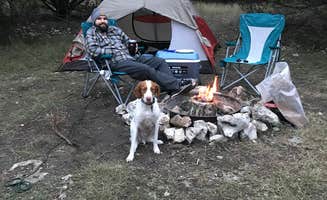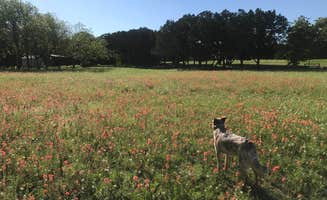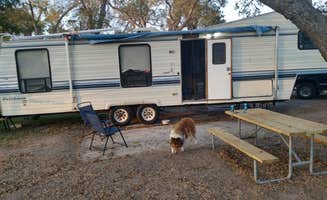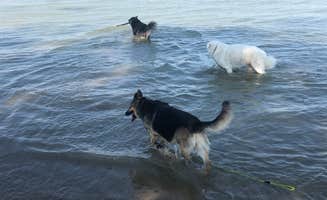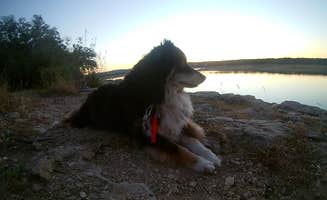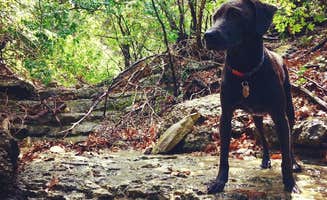Dispersed camping near Georgetown, Texas offers diverse terrain with direct lake access from many sites. Lake Georgetown is situated at an elevation of approximately 791 feet and spans 1,310 acres with a 26-mile perimeter trail. Campsites range from lakeside locations with water and electrical hookups to primitive sites requiring a hike-in approach with limited facilities.
What to do
Hiking the Goodwater Loop: Access the 26.2-mile trail system directly from multiple Georgetown campgrounds. "The Good Water Loop goes all the way around the lake and passed through the park. The trail is very rugged for bikes. The boat traffic on the lake was pretty low so it's a good place to take a kayak or canoe," notes Laura F. from Jim Hogg - Lake Georgetown.
Swimming in natural areas: Cool off at designated swimming spots during summer months. "Nice campsites, clean bathrooms, lake access for swimming/boating/paddling. I didn't get a single mosquito bite while camping here! Lots of shade with plenty of tree covering. Cleanest lake I've been to in Texas!" shares Terry W. about Cedar Breaks Park.
Kayaking and fishing: Take advantage of the calm water conditions for paddling. "Jim Hogg is a campsite on lake Georgetown, they don't have a direct swim access but they do have a boat access. primitive camp sites are nice not too close to each other," explains amber N.
What campers like
Spacious, private sites: Many campgrounds offer good separation between neighbors. "I have stayed at this campground several times. The campground is well-maintained with spacious sites. Many of the sites are wooded. Each site has a shelter with a concrete base. The sites have water and electric," reports Kenneth H.
Covered picnic areas: Most established sites include shelters for shade and weather protection. "Lots of spots on the lake. They do have gazebos at each spot. Campground is very clean. Spent a day by the water but our spot didn't have shade so we moved inland under the trees and it was much more comfortable," says Ryan G. about Jim Hogg Park.
Primitive camping options: For those seeking a more remote experience away from RVs. "Tejas Park is perfect for those in the area looking for tent camping without wanting to be surrounded by RV's. Tejas is right on the river, ample opportunities to wet a line if you like," explains Mark S. from Tejas Park.
What you should know
Seasonal considerations: Summer heat requires preparation. "In the summer be aware that the combination of the temperature and the exposure can make this trail uncomfortable to hike. Take precautions, drink lots of water and stay in the shade all that you can," advises Troy W. about the trails around Sawyer Park Primitive Campsites.
Wildlife awareness: Be prepared for encounters with local fauna. "Watch out for RATTLESNAKES. We saw 2," warns Mark S.
Limited facilities at some sites: Not all campgrounds offer full amenities. "Restrooms are very basic with no hot water. They were clean but a little creepy for showers. I used the toilets there during the day and my camper shower and toilet at night," shares Karen H.
Tips for camping with families
Best family-friendly locations: Choose sites with convenient facilities. "Great escape on the water for a weekend. Not a lot of shade, but sites are OK," notes J E.
Child-friendly swimming spots: Some areas have better water access than others. "My 5 year old wanted to go camping for the first time. This location is close enough to be near civilization, but feels remote to get the primitive camping experience. The sites have a pad to set up your tent, along with fire rings and plenty of shade," recommends Steve L. about Berry Springs Park & Preserve.
Pet-friendly options: Georgetown offers numerous accommodations for four-legged family members. "Nice RV park near Georgetown Texas about 20 north of Austin. They are a mile or so off of I 35 which makes this easy to access. They have ample space and lots of amenities. Nice choice for long term or just passing through," explains Steve & Ashley G.
Tips from RVers
Site selection strategy: Choose level sites for easier setup. "The sites along the outside of the loop have lake views and are level. The sites along the inside are scary unlevel! Some of the big rigs were backed in and jacked up 4 feet or so in front," warns Karen H.
Dump station locations: Plan for waste management before departure. "Cons: Dump station is at entrance of park and park is fairly large to haul a portable dump tank," notes Mocsaw $ from Jim Hogg Park.
Electric hookup options: Most established campgrounds offer power connections. "We have an access pass which gives us half off each night - $13 per night. Can't beat that deal for 50/30 and water. No sewer hookups so we use our Honey Wagon or we call affectionally 'Poopsie' that we take to Cedar Breaks dump site," shares Mary S.




